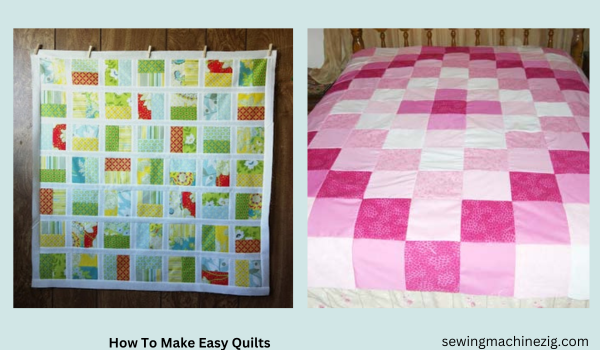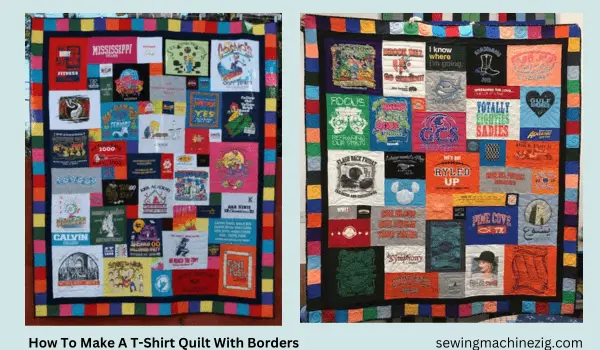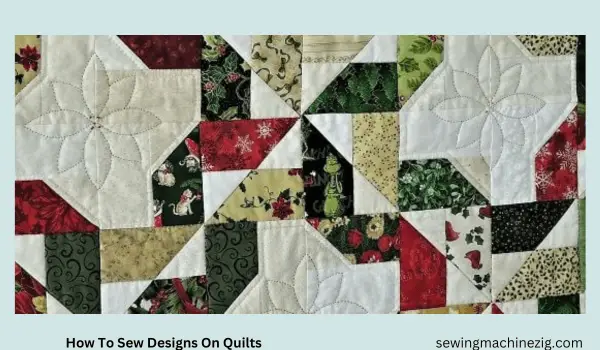
Quilting diagonal lines is a popular technique that can add interest, texture, and dimension to your quilt. Unlike traditional straight-line quilting, diagonal lines can create a more dynamic and modern look. How to quilt diagonal lines well Whether you’re a beginner or an experienced quilter, quilting diagonal lines is a fun and rewarding technique that can be used to enhance any quilt design.
In this article, we will guide you through the steps for How to quilt diagonal lines, including tips for achieving even stitching and a professional-looking finish. Whether you’re quilting a small project or a large quilt, these tips and techniques will help you create beautiful, modern designs that will impress and delight you.
Materials:
- Quilt top
- Quilt batting
- Quilt backing
- Fabric pen or pencil
- Quilting ruler
- Rotary cutter
- Walking foot
- Quilting needle
- Quilting thread
Step-By-Step Guide:
Step 1: Mark The Quilt Top
Using a fabric pen or pencil and a quilting ruler, mark diagonal lines on your quilt top.
Example: if you’re quilting a baby quilt that measures 36 inches by 36 inches, you might mark diagonal lines that are 2 inches apart. Start by marking a line from the top left corner to the bottom right corner, then mark additional lines parallel to this line at the desired distance.
Step 2: Layer The Quilt
Layer the quilt top, batting, and backing together, making sure they are smooth and even. Pin or baste the layers together to hold them in place.
Step 3: Prepare Your Machine
Attach a walking foot to your sewing machine and thread your machine with quilting thread. Use a quilting needle for the best results.
Step 4: Begin Quilting
Starting at the top left corner of the quilt, the quilt along the marked diagonal lines, using the walking foot to help guide the layers evenly. Leave a small margin of about 1/4 inch from the left and right edges of the quilt top as you quilt.
Example: if your quilt top measures 36 inches by 36 inches, you would leave a 1/4 inch margin at the left and right edges of the quilt top.
Step 5: Continue Quilting
Continue quilting along the diagonal lines until you reach the bottom right corner of the quilt. Take care to keep the lines straight and even, and to maintain the same distance between the lines throughout the quilt.
Step 6: Backstitch At The End
When you reach the end of the quilt, backstitch a few stitches to secure the thread, then trim the thread.
Step 7: Quilt The Other Direction
If you want to add more dimension and interest to your quilt, you can quilt diagonal lines in the opposite direction as well. To do this, mark diagonal lines that are perpendicular to the first set of lines, and quilt along these lines in the same manner.
Step 8: Finish The Quilt
Once you have finished quilting the diagonal lines, trim the excess batting and backing from the edges of the quilt. Add binding to the edges of the quilt to finish it off.
Example: if your quilt measures 36 inches by 36 inches, you would need to cut binding strips that are approximately 160 inches long (4 strips at 40 inches each) to go around all four sides of the quilt. I hope now you’re aware of How to quilt diagonal lines.
How To Mark Diagonal Quilt Lines
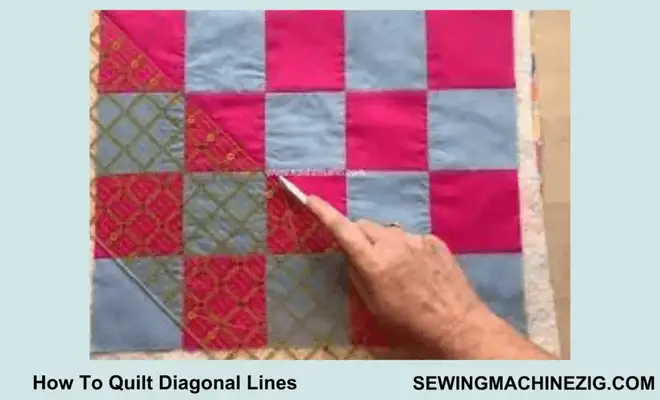
It’s important to learn before you can get how to quilt diagonal lines, because when quilting with diagonal lines, it’s essential to mark your fabric to ensure that your lines are straight and evenly spaced. Here are some methods for marking diagonal quilt lines:
1. Tape And Ruler Method:
Place painter’s tape diagonally across your quilt top, then use a quilting ruler to mark evenly spaced lines along the tape.
2. Chalk Or Washable Marker Method:
Use a chalk or washable marker to draw a diagonal line across your fabric, then use a quilting ruler to mark evenly spaced lines along the diagonal.
3. Masking Tape And Marker Method:
Place masking tape diagonally across your quilt top, then use a permanent marker to mark evenly spaced lines along the tape.
4. Stencil Method:
Purchase a diagonal quilting stencil, place it on your quilt top, and use a washable marker or chalk to mark the lines.
5. Freehand Method:
If you’re confident in your ability to sew straight diagonal lines, you can skip the marking step altogether and sew the lines freehand.
Whichever method you choose, test the marking tool on a scrap of fabric before using it on your quilt top to ensure that it will wash out cleanly. Also, remember to leave a small margin of about 1/4 inch from the left and right edges of the quilt top when marking your diagonal lines to ensure that your lines are straight and even. This is another process of How To Quilt Diagonal Lines.
How To Sew A Quilt With Diagonal Rows
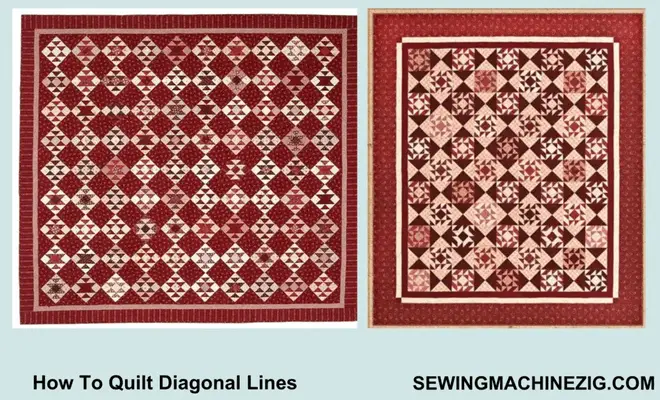
Sewing a quilt with diagonal rows can create a beautiful, dynamic design that adds interest and texture to your finished project. This technique involves piecing fabric strips together at a diagonal angle to create rows of triangles, which can then be arranged into a variety of unique designs. Whether you’re a beginner or an experienced quilter, sewing a quilt with diagonal rows is a fun and rewarding project that can be personalized to match your individual style and preferences.
In this article, we will guide you through the steps for how to quilt diagonal lines or sew a quilt with diagonal rows, including tips for choosing fabrics, cutting and piecing the material, and assembling the quilt top.
Materials:
- Fabric in various colors and prints
- Quilting ruler
- Rotary cutter
- Sewing machine
- Quilting thread
- Batting
- Quilt backing fabric
- Fabric scissors
Step-By-Step Guide:
Step 1: Choose Your Fabric
Select a variety of fabrics in complementary colors and prints. Cut the fabric into strips of equal width, such as 2 1/2 inches or 3 inches.
Step 2: Cut The Fabric Strips
Using a quilting ruler and rotary cutter, cut the fabric strips at a 45-degree angle to create diagonal strips.
Step 3: Piece The Diagonal Rows
Sew the strips together at a diagonal angle to create rows of triangles. For example, sew together two diagonal strips of fabric to create a row of triangles. Repeat this process to create additional rows.
Step 4: Press The Seams
Press the seams open or to one side as desired to create a smooth surface.
Step 5: Cut The Diagonal Rows
Using a quilting ruler and rotary cutter, trim the diagonal rows to the desired size, leaving a small margin of about 1/4 inch from the left and right edges of the rows. For example, if your diagonal rows measure 12 inches by 48 inches, you would leave a 1/4 inch margin at the left and right edges of each row.
Step 6: Arrange The Rows
Lay out the diagonal rows in a pleasing arrangement, experimenting with different layouts until you find one that you like.
Step 7: Sew The Rows Together
Sew the diagonal rows together to create the quilt top, leaving a small margin of about 1/4 inch from the left and right edges of the quilt top as you sew. For example, if your quilt top measures 48 inches by 60 inches, you would leave a 1/4 inch margin at the left and right edges of the quilt top.
Step 8: Finish The Quilt
Once you have finished sewing the quilt top, layer it with batting and quilt backing fabric, and quilt it together as desired. Finally, add binding to the edges of the quilt to finish it off.
How To Quilt Diagonal Lines On A Longarm
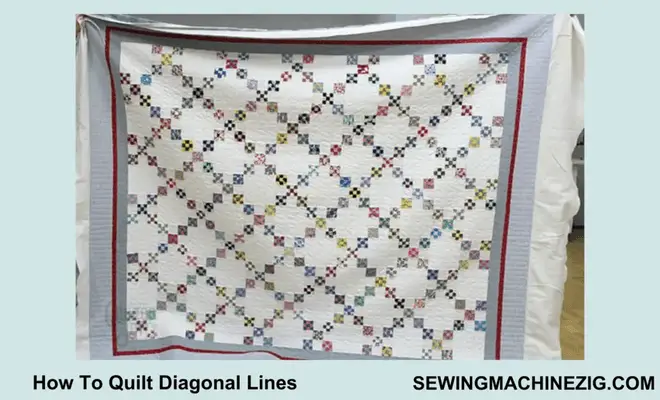
How to quilt diagonal lines also includes How To Quilt Diagonal Lines On A Longarm. Quilting diagonal lines can add a modern and dynamic look to any quilt. If you have access to a longarm quilting machine, you can easily achieve this look. Longarm quilting machines are large, industrial machines that make it easier to maneuver the fabric and create intricate designs. While quilting diagonal lines on a longarm machine can be a bit different than quilting on a domestic sewing machine, the process is straightforward and can be accomplished with the right tools and techniques.
In this article, we’ll go over the steps to How to quilt diagonal lines on a longarm quilting machine, so you can add a unique touch to your quilting projects.
Materials:
- Longarm quilting machine
- Quilting thread
- Longarm quilting ruler
- Quilt top, batting, and backing fabric
- Water-soluble marker or chalk
- Fabric scissors
Step-By-Step Guide:
Step 1: Load The Quilt Onto The Longarm Frame
Follow the manufacturer’s instructions to load your quilt top, batting, and backing fabric onto the longarm quilting frame. Be sure to leave at least 4-6 inches of extra fabric on each side of the quilt top. For example, if your quilt top measures 60 inches by 80 inches, your backing and batting should measure at least 68 inches by 88 inches.
Step 2: Choose Your Thread And Quilting Design
Select a thread color that complements your quilt top, and choose a quilting design that incorporates diagonal lines. For example, you could choose a variegated thread in shades of blue and purple, and use a simple diagonal line design.
Step 3: Attach The Longarm Quilting Ruler
Attach a longarm quilting ruler to the machine, making sure it is at a 45-degree angle to the quilt top. For example, you could use a straight ruler or a curved ruler, depending on your desired quilting design.
Step 4: Mark Your Starting Point
Using a water-soluble marker or chalk, mark the starting point of your first diagonal line. Start from one corner of the quilt top and move diagonally across to the opposite corner. For example, if you want to quilt from the bottom left corner to the top right corner, mark a line 1/4 inch from the edge of the quilt top.
Step 5: Quilt The Diagonal Lines
Using the longarm quilting ruler as a guide, quilt along the marked line. For example, you could use a simple straight stitch or a decorative serpentine stitch.
Step 6: Adjust The Ruler As Needed
As you quilt, adjust the longarm quilting ruler to ensure that your lines are straight and even. For example, you may need to move the ruler slightly to the left or right to maintain a consistent diagonal line.
Step 7: Mark The Next Diagonal Line
Move the quilt top to the next diagonal line, and mark your starting point. Again, leave a margin of about 1/4 inch on both sides of the marked line. For example, if you want to quilt from the top left corner to the bottom right corner, mark a line 1/4 inch from the edge of the quilt top.
Step 8: Repeat The Process
Continue quilting along the marked lines, moving from one corner of the quilt to the opposite corner. Repeat the process until you have quilted all of the diagonal lines. For example, if you want to quilt a grid of diagonal lines across the entire quilt top, you will need to mark and quilt each diagonal line until the quilt is fully quilted. I hope now you’re aware of How to quilt diagonal lines on a longarm quilting machine.
Simple Quilting With Straight Diagonal Line
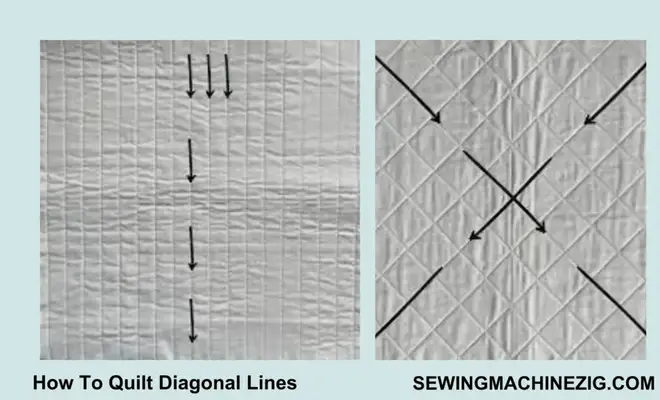
Straight diagonal line quilting is a simple yet effective way to create a beautiful geometric pattern on your quilt. This technique is perfect for beginners or those looking for a quick and easy quilting project.
How to quilt diagonal lines? Well with just a few materials and some basic sewing skills, you can create a stunning quilt that will impress your family and friends. The best part about straight diagonal line quilting is its versatility – you can use any color or pattern of the fabric to create a unique and personalized quilt. So, whether you’re new to quilting or an experienced crafter, give straight diagonal line quilting a try and see the beautiful results for yourself!
Conclusion:
Quilting diagonal lines is a great way to add interest and texture to your quilt. Whether you’re using a domestic sewing machine or a long-arm quilting machine, the process is relatively simple and straightforward.
Hope you learn well now How to quilt diagonal lines by following the steps outlined in this article. You can create beautiful and unique diagonal line quilting patterns that will enhance the overall look and feel of your quilt. Remember to take your time and practice on scrap fabric before moving on to your actual quilt. With some patience and persistence, you can master the art of quilting diagonal lines and create stunning quilts that you and your loved ones will cherish for years to come.”How to quilt diagonal lines“
FAQs:
Here are the most frequently asked questions about how to quilt diagonal lines, along with detailed answers:
Q 1: What is the best fabric for quilting diagonal lines?
A: Any type of quilting cotton or quilting fabric will work for quilting diagonal lines. It is important to choose a fabric that is not too heavy or too light and has enough body to hold the quilting stitches.
Q 2: Do I need special equipment for quilting diagonal lines?
A: You don’t necessarily need special equipment for quilting diagonal lines, but a walking foot or a free-motion foot for your sewing machine can be helpful. A long-arm quilting machine is also a good option for quilting diagonal lines on larger quilts.
Q 3: How do I mark diagonal lines on my quilt?
A: You can use a ruler and a fabric pen or pencil to mark diagonal lines on your quilt top. Alternatively, you can use quilter’s tape or masking tape to mark your diagonal lines.
Q 4: How far apart should I space my diagonal quilting lines?
A: The spacing of your diagonal quilting lines depends on personal preference and the size of your quilt. As a general rule, you can space your quilting lines anywhere from 1/4 inch to 2 inches apart.
Q 5: Can I use different colors of thread for quilting diagonal lines?
A: Yes, using different colors of thread for quilting diagonal lines can create a beautiful and unique effect. Just make sure to choose thread colors that complement your quilt top.
Q 6: How do I keep my quilt from puckering while quilting diagonal lines?
A: To prevent your quilt from puckering while quilting diagonal lines, make sure to use a quilting batting that has a good loft and is not too thin. It is also important to keep your quilt top and batting smooth and taut while quilting.
Q 7: Can I quilt diagonal lines on a hand-sewn quilt?
A: Yes, you can quilt diagonal lines on a hand-sewn quilt. Simply mark your diagonal lines with a fabric pen or pencil and use a needle and thread to quilt along the marked lines.

